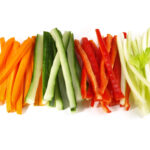Dip your veg sticks and bread into this smooth and creamy houmous wreath!
Chickpeas are packed with protein and can make a delicious snack when blended into a dip. Top your wreath with a variety of herbs and cherry tomatoes for a festive snack.
Skills Check
Follow a recipe; follow food safety & hygiene rules; tidy away; use measuring spoons and cups; use balance/digital scales; chop using bridge/ claw safely; use a vegetable peeler safely; crush garlic; use a citrus squeezer.
Equipment
Knife, Chopping Board, Food Processor, Bowl, Spoon, Scissors, Jug, Plate
Allergens*
None
*Please note the allergens listed are indicative only. Allergens vary depending on brand; check the labels on the products you use.
Ingredients (serves 6, or 8 as a taster):
- 170g canned chickpeas in water (drained weight)
- 2 small cloves of garlic, crushed
- 2 tbsp olive oil
- 1/4 tsp ground cumin
- 1/4 tsp ground coriander
- Freshly squeezed juice of 1 lemon
- 1/4 tsp ground black pepper
- Pinch of salt
For decoration:
- Parsley
- Cherry tomatoes
- Red Pepper
Method
- Put all of the ingredients into a food processor and blend together until you have a coarse paste. Slowly add water if needed and mix to loosen the mixture.
- Spoon into a large dish and shape into a circle/ ring.
- Snip the parsley in a jug with scissors.
- Carefully cut the cherry tomatoes in half using the bridge/claw techniques safely.
- Decorate your wreath with the parsley and tomatoes and serve with raw vegetables (e.g. cherry tomatoes, cucumber & carrot sticks, pepper sticks) and bread of your choice - especially nice with toasted wholemeal pitta bread cut into fingers.
So thinking about a houmous wreath ...

Vegetables are so good for us! Low in fat, sugar and calories and high in vitamins and minerals.
Nutritional Information
| - | Energy | 494 | 6% |
| Med | Fat | 3.5g | 5% |
| Low | Saturates | 0.4g | 2% |
| Low | Sugars | 1.2g | 1% |
| Low | Salt | 0.09g | 2% |
per 74g serving
% of an adult's reference intake
Typical values per 100g: Energy 443kJ / 106kcal
Notes
A traffic light system is used on nutrition labels to make it easier to see which foods and drinks are lower in calories, fat, sugar and salt. Try and choose more ‘greens’ and ‘ambers’ and fewer ‘reds’, and stick to smaller portions of ‘reds’.
Just because a recipe or a food has a red traffic light doesn’t mean you shouldn’t eat it. Understanding why a food or recipe might have a red light can be helpful. For example oily fish is high in total fat and so any recipe containing oily fish is likely to be ‘red’ for fat. But it is recommended that we eat oily fish at least once a week because the type of fat it contains is beneficial for our health.
% Reference Intakes are also shown. Reference Intakes are guidelines about the approximate amount of particular nutrients and energy required for a healthy diet (based on an average-sized woman doing an average amount of physical activity). Most children will require less than these Reference Intakes. The contribution of one serving of a food or drink to the Reference Intake for each nutrient is expressed as a percentage.




